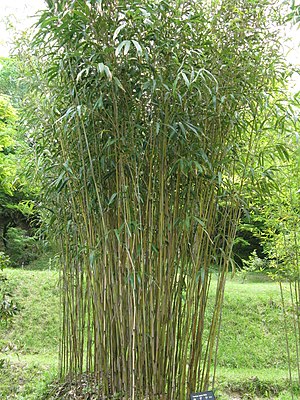Japanese arrow bamboo
| Japanese arrow bamboo | ||||||||||||
|---|---|---|---|---|---|---|---|---|---|---|---|---|

Pseudosasa japonica |
||||||||||||
| Systematics | ||||||||||||
|
||||||||||||
| Scientific name | ||||||||||||
| Pseudosasa japonica | ||||||||||||
| ( Sieb. & Zucc. Ex Steud. ) Makino ex Nakai |
The Japanese arrow bamboo ( pseudo japonica , . Syn : Arundinaria japonica ) is a bamboo - type of the genus Pseudomonas Sasa .
description
It is a runners-forming medium-high bamboo (height of 3 to 5 meters) with upright growth and overhanging tips. The stalks have a diameter of about 1 cm and are olive green with beige stalk sheaths. The internodes are long, finely speckled and finely serrated with a light wax ring under the nodes. The branches grow individually from thickened nodes and do not branch any further. The lower part of the stalks usually has no branches. The leaves are 15 to 30 cm long and 2 to 4 cm wide. Five to seven sit in groups at the ends of the branches. The leaf is medium to deep green on top, silvery green on the underside, it is glossy, oblong-lanceolate .
The number of chromosomes is 2n = 48.
etymology
The generic name Pseudosasa is derived from pseudos (Greek ψεῦδος) = "false, fake" and sasa (Japanese) = "bamboo grass". Japonica means Japanese. The German name arrow bamboo, like the Japanese name Yadake ( Japanese 矢 竹 ), indicates the use of the stalks as arrows for the Japanese longbow . For this purpose, two-year-old stalks are straightened after a drying time in several steps after heating over a fire and smoothed by grinding.
distribution
The species is native to South Korea ( Jeju-do Island ) and Japan. There he lives in damp locations.
Culture
It is a robust, easy-care and very frost-hardy (winter hardiness up to −20 ° C) bamboo and loves a partially shaded location. It prefers moist and swampy soils, but also thrives on dry and barren soils. It was introduced in Europe around 1850 and is one of the most common bamboos in European gardens. The last bloom was in the 1980s.
In Japan and China arrows have been made from stalks for more than 1200 years. This bamboo is therefore often found in the vicinity of castles, palaces and ruins.
literature
- Simon Crouzet and Oliver Colin: Bamboo. Agrarverlag 2003, ISBN 3-8001-4195-7 .